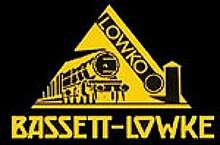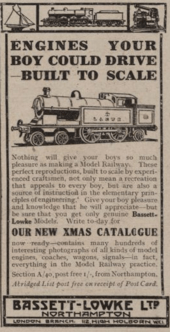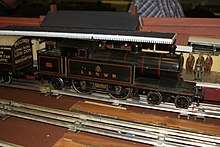Bassett-Lowke
Bassett-Lowke was a toy company in Northampton, England, founded by Wenman Joseph Bassett-Lowke in 1898 or 1899, that specialized in model railways, boats and ships, and construction sets. Bassett-Lowke started as a mail-order business, although it designed and manufactured some items.


Overview
Bassett-Lowke was a sales organization, contracting manufacturers such as Twining Models and Winteringham Ltd, also of Northampton. Until World War I, the company also carried models made by Bing and Märklin.
Ship models
Today the name Bassett-Lowke is mostly associated with detailed model trains but the company also had a long history of contracting skilled craftsmen to make scale military and civilian waterline ship models out of wood and wire. *Derick Head in his "Bassett-Lowke Waterline Ship Models", states that before and during World War One, there was such a demand for these hand-made waterline wooden ship models that the company had to contract with a "small metal casting company" to supply more waterline ship models to meet the demand. The name of the metal casting company referred to in Mr. Head's book was Brighton Manufacturing Company Ltd, 32 Great St Helens, London, England. This metal casting company was within walking distance from the prominent glass display windows of the Bassett-Lowke shop located on High Holborn St. in London. The metal ship models supplied by this small company were referred to in the Bassett-Lowke sales literature simply as "B.M.C.". The collaboration between Bassett-Lowke and B.M.C. produced the first metal ship models in a uniform scale to each other ever made.
These B.M.C. models were the forerunners of all the scale metal recognition models made by companies in later years such as Tremo, Viking and Authenticast. The resulting model fleet in metal carried in the Bassett-Lowke catalog was of every class of ship in the British navy then in commission as of 1914. The models found in the collection range from the early 1882 Royal Sovereign class Pre-Dreadnoughts, some of which had been retained by the navy as bombardment ships, through the newest Revenge class Super-Dreadnoughts which had just come into service. The 1917 Bassett-Lowke catalogue makes the claim that "Practically every ship in the Navy has been modeled, including Super-Dreadnoughts, Battleships, Battle Cruisers, Armored Cruisers, Light Cruisers, Destroyers, Torpedo Boats, Submarines, Mine Layers, Mine Sweepers, Troopships, Transports, Armed Liners and all Auxiliary Craft". The models were formed in lead with the wire masts cast into the hulls in a scale of one inch equals 150 feet or 1/1800. They were painted and issued in numbered boxed sets, paper flags supplied with each set to be cut out and applied to the masts and sternposts.
Every class of vessel was easily recognizable by the funnels, guns and masts. While rudimentary by later standards, the B.M.C. production of over 101 different castings was the first scale metal ship model fleet ever produced and established the precedent all subsequent scale metal recognition ship models. In addition to the ship models, B.M.C. produced a fort with movable guns, four lighthouses and a game featuring a large fold-out map of the Dardanelles channel showing forts and minefields. The game was supplied with fifteen metal ship models including two mine sweepers and two submarines.
The B.M.C. ship models often appear for sale on internet auctions and at toy shows. Many times at these sales the B.M.C. models are found mixed with copies made by two later companies. The B.M.C. models can be distinguished from the copies since only the B.M.C. models have full-length wire masts cast into the hulls. The first type of copies are 26 models made by "Minifigs" These are cast in solid lead, have no wire masts and have large numbers inscribed on the bottom. The second type of copies comprise a group of four models made by Crescent which are cast in pot metal. They have numbers near the starboard stern numbering B.1, B.2, B.3, or B.4. Curiously, these pot-metal models retain the same numbering system that is cast into the hulls of the four B.M.C models from which they were derived.
These Crescent copies mimic the B.M.C. castings of the B.I Duncan, B.II Swiftsure, B.III King Edward VII, and the B.IV Lord Nelson. It is unknown when Bassett-Lowke ceased carrying the B.M.C metal ship models but the larger 1:1200 scale wood and wire ship models continued to be produced by Bassett-Lowke in both World War I and World War II. These larger wood and wire ship models in the scale of one inch equals 1200 inches or 1:1200, were sold commercially to the public and were used by the military for recognition and war gaming purpose. Unlike the B.M.C. lead models, which are in 1/1800 scale and are obscure to most collectors, these larger wooden ship models are sought after and command a high price.
Model Trains
.jpg)

Bassett-Lowke produced trains from 15-inch (381 mm) gauge live steam models to Gauge 2, Gauge 1 and 0 gauge.
The first 15-inch steam locomotive, test run on the Eaton Hall Railway in 1905, was Little Giant. Unlike other engines on the line, it was a replica of main-line locos, built for a public miniature railway at Blackpool. It was a quarter-scale 4-4-2 "Atlantic" tender engine, though not an exact copy of any particular prototype. That engine still exists in private ownership.
In 1909, along with Henry Greenly, W.J. Bassett-Lowke started and edited Model Railways and Locomotives Magazine.
In 1914, Bassett-Lowke produced the second "Pacific" 4-6-2 of any size built in Britain (the first was GWR 111 The Great Bear). That was John Anthony, built for a miniature railway at Staughton Manor, Cambridgeshire. It was never delivered, but after storage at Eaton Hall during World War I, was sold to the Ravenglass and Eskdale Railway and renamed Colossus. It was scrapped in 1927. Ravenglass and Eskdale had purchased another Bassett Lowke Atlantic, the Sans Pareil.
In the 1920s, Bassett-Lowke introduced 00 gauge products. The company provided custom-built railways, and one such gauge 1 layout survives in modified format at Bekonscot Model Village in England.
In 1939, Bassett-Lowke was tasked with producing a working model of Churchill's trench-digging tank known as Cultivator No. 6.[1]
Bassett-Lowke's decline, starting in the late 1950s, can be blamed on at least two factors: people would browse the firm's free catalogue and buy similar or nearly identical items elsewhere at lower price; and the interest in technical toys declined in the late 1950s and even more in the 1960s. Bassett-Lowke's fall was mirrored by its U.S. counterparts, the A. C. Gilbert Company and Lionel Corporation. In 1964, the company ceased retail sales and sold its shops, including one at High Holborn in London, to Beatties. Bassett-Lowke went out of business in 1965.
In 1966, the company was acquired by Messrs Riley and Derry. Around 1969, Ivan Rutherford Scott, Allen L. Levy and Roland H. Fuller apparently made an effort to revive the model railway business.[2] In the late 1980s, Nigel Turner, a Northampton businessman, bought the business and based it next to his business, Turner's Musical Merry-Go-Round, near Wootton, Northamptonshire. In 1993, the name was revived with short-run white-metal models. These included a Burrell-type traction engine, Clayton undertype steam wagon, Burrell-type steam roller, and a London B-type bus. The name was acquired in 1996 by Corgi, which linked it with live steam 0-gauge locomotives.
Key competitors to Bassett-Lowke were Hornby and Exley.
Hornby acquired Corgi in 2008 and originally continued to make the 0 gauge models before later discontinuing them. The brand name was revived by them in 2020 for a range of 00 scale steampunk models based on existing Hornby toolings.
Narrow Gauge Railways Ltd
In 1912 W. J. Bassett-Lowke, Robert Proctor-Mitchell and John Wills set up Narrow Gauge Railways Ltd (NGR) to promote and run 15-inch (380 mm) railways. An earlier company, Miniature Railways of Great Britain Ltd, went into voluntary liquidation in 1912. NGR's first railway opened in 1912 at Luna Park in the Parc des Eaux-Vives, Geneva, Switzerland. In Britain, the Ravenglass and Eskdale Railway was taken over, converted to 15-inch (380 mm) gauge and re-opened in 1915. The Fairbourne Railway followed in 1916.
Locomotives
Bassett-Lowke locomotives were often renamed when moved to different railways, sometimes creating uncertainty about whether a locomotive is new or an old one with a new name. The list (probably incomplete) is not definitive. Most of Bassett-Lowke's locomotives were designed by Henry Greenly who was a contributor to Model Engineer magazine.[3]
Class 10 Atlantic
- Little Giant for Blackpool
- Mighty Atom for Sutton Miniature Railway
- Entente Cordiale for the 1909 Exposition Internationale de l'Est de France in Nancy
- Red Dragon for the Imperial International Exhibition of 1909 at White City, London
- Green Dragon for the Imperial International Exhibition of 1909 at White City, London
- King Edward for the 1910 International and Universal Exhibition in Brussels, Belgium
- King Albert for the 1910 International and Universal Exhibition in Brussels, Belgium
- King Leopold for the 1910 International and Universal Exhibition in Brussels, Belgium
- George the Fifth for Lakeside Miniature Railway
- Hungaria (No. 19) built in 1912 originally for Luna Park Geneva, Switzerland, then taken to Vidámpark (Amusement Park), Budapest, Hungary in 1914. Boiler changed in 1952, withdrawn in 1974, taken to a scrapyard but saved by the Transport Museum. Currently displayed in Zánkafürdő Railway Station, Hungary.
Class 20 Atlantic
- Prince Edward of Wales for Fairbourne Railway
- Prince of Wales for Lakeside Miniature Railway
Class 30 Atlantic
- Synolda for Sand Hutton Miniature Railway, then to Belle Vue, Manchester, later Southend-on-Sea, currently Ravenglass and Eskdale Railway.
- Sans Pareil for Luna Park, Geneva, Switzerland, then to Ravenglass and Eskdale Railway.
- Count Louis for Count Louis Zborowski, then to Fairbourne Railway. then to Evesham Vale Light Railway and now (2019) tours railways around the UK.
Class 60 Pacific
- John Anthony for J.E.P. Howey, then (renamed Colossus) to Ravenglass and Eskdale Railway.
The Class 10 and Class 20 had narrow fireboxes. The Class 30 and Class 60 had wide fireboxes.
See also
- Model Engineer magazine
- Ridable miniature railway
References
- Newman 1956, p. 21.
- They wrote the introduction to a limited-edition album called "Bassett-Lowke: A Commemorative Edition" (1969). The volume commemorated the Flying Scotsman's tour of the US that year, a tour in which Bassett-Lowke participated. In the introduction the authors stated that the industrial model-making business and the railway model-making had been split, with the former continuing as Bassett-Lowke Limited in Northampton, and the latter as Bassett-Lowke (Rlys) Limited at 59 Cadogan Street, London, sharing space with Steam Age. The book showed the products they intend to bring to market.
- Model Engineer magazine 3810 (1987)
- Derick Head "Bassett-Lowke Waterline Ship Models", New Cavendish Books; ISBN 1872727727
- Fuller, Roland; Levy Allen "The Bassett-Lowke Story", New Cavendish, ISBN 0-904568-34-2 / 9780904568349
- Mosley, D. and van Zeller, P. (1986) Fifteen inch gauge railways : their history, equipment and operation, Newton Abbot : David & Charles, ISBN 0-7153-8694-8
- Newman, Bernard (17 March 1956). "Churchill's Forgotten Monster". Picture Post. Hulton. 70 (11): 21–23, 52.CS1 maint: ref=harv (link)